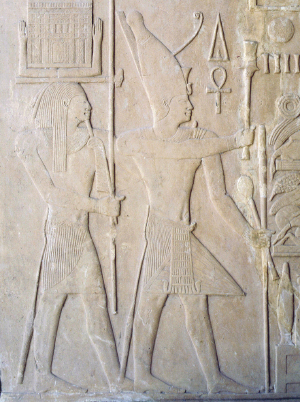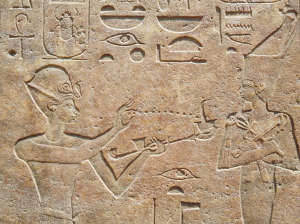Rebellion of Korah and Reubenites (16:1—17:13)
Korah . . . became insolent (16:1). In tribal and clan-structured societies of the ancient Near East, the position of leadership often fell on the eldest son of the family patriarch. The men of Reuben, Jacob’s firstborn, sought to claim what they perceived as their rightful positions in Israel, thereby usurping the role of Moses, with Korah supplanting Aaron. Korah’s lineage is traced back fully through three major figures in the levitical line. As a Kohathite, Korah was among the favored clan of the Levites whose responsibility was to transport the sacred furnishings of the tabernacle after being packed by the Aaronic priests (4:1–20).125
Take censers . . . and put fire and incense in them (16:6–7). The censers for incense were pans or shallow bowls at the end of long handles (Lev. 10:1). These pans carried hot coals on which incense could be sprinkled, creating a savory aroma. Such censers are believed to have originated in Egypt, where they were used in the performance of apotropaic magic for driving away evil deities or demonic forces by waving them in a ritual manner.126

Incense censer
Loic Evanno/Wikimedia Commons, courtesy of the Louvre
Alive into the grave (16:33). The grave (Sheol) at this point in Israel’s history was perceived to be a shadowy, unknown realm of the dead—the netherworld of both good and evil where one was gathered to one’s fathers at death.127 Normally, one places a dead person in a cave or man-made tomb, where the body slowly deteriorated. Later the bones of the deceased were added or gathered to those of one’s ancestors in the ancestral burial site. But in this incident the bodies of the rebels (and perhaps their families as well as their possessions) plummeted into a gaping abyss, which soon closed over them with collapsed dirt and rock of the desert terrain. The second census informs us that Korah’s fate was the same as that of Dathan and Abiram (26:10).
Sheol is described as opening it mouth to receive the dead (Prov. 1:12; Isa. 5:14; Hab. 2:5) in a manner parallel to the Canaanite god Mot. In the Baal Cycle, the champion deity admonishes his emissaries to Mot to beware “lest he put you in his mouth like a lamb, and crush you like a kid in his jaws.” Later Baal himself is mortally wounded and descends into the belly of Mot, who “stretched out his tongue to the stars, Baal entered his innards, he descended into his mouth.”128 Here the realm of Sheol and the dead is under the sovereign power of Israel’s God; since Moses pronounces the curse prior to the event, no one can mistake the judgment as circumstantial.
Fire came out from the LORD (16:35). A fiery storm of divine judgment from the god Enlil is depicted in the Lament over the Destruction of Sumer and Ur, in which the city, its crops, and its inhabitants are destroyed.129 Phenomena that today are considered “natural” disasters were not thought of as natural in the ancient world.130 Lightning was considered fire from heaven. The god Enlil is said to make stones and fire rain upon his foes.131 The Assyrian king Ashurbanipal reports on one occasion that fire fell from heaven and consumed his enemies.132
Write the name of each man on his staff (17:2). The staff was the official symbol of the tribal chieftain, which in Babylonia and Egypt often were designed so as to signify its owner.133 The word maṭṭeh means both “tribe” and “staff/scepter” and hence carried some representation of the tribe’s identity. In this context the names were inscribed for unmistakable identification.
The use of wood articles to discern the will of the gods is well documented in the ancient Near East, wherein the wooden symbols of Asherah, Astarte, or Ishtar are used in fertility rites. Even in Egypt Asherah was combined with Hathor during the Nineteenth Dynasty and represented as a nude figure standing on a lion and holding snakes and flowers.134 In the Ugaritic Incantation against Sorcery, Baal drives off a man’s accuser with his staff into the underworld.135 Such cultic practices were forbidden and condemned elsewhere in the Old Testament.136

Sesostris here holds the kherep scepter. There were numerous scepters in Egypt that designated different powers. The kherep pictured here was an insignia of office that could also be used by others besides the king.
Werner Forman Archive
